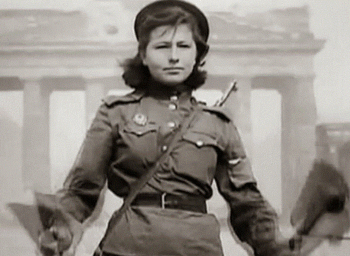Maria Limanskaya

Maria Limanskaya (also mistakenly referred to as Anna Pavlova) was a female soldier of the Red Army for three years during World War II. She became known as the Russian woman who directed traffic at the Brandenburg Gate in 1945 after the Battle of Berlin. She has since become a symbol of the Allied victory over Nazi Germany.
Biography
Early life and military service
Born in 1924 as Maria Limanskaya, she joined the Red Army in 1942, at the height of World War II. She was 18.[1][2] At that time the Soviet Stavka ("high command") increasingly lacked trained reserves to reinforce the entire 2,000-kilometre (1,200 mi) front, and as a result began to conscript underage men and women.[3] Almost 800,000 women would eventually serve in the Red Army throughout the war.[4] Little is known about Limanskaya's military career other than several occasions where she was nearly killed. At one point, she left a building a few seconds before it was leveled by a bomb attack. She also contracted malaria.[1][2]
Brandenburg Gate and victory icon
After the Battle of Berlin ended in early May 1945, Limanskaya was assigned to direct traffic at the Brandenburg Gate during the Potsdam Conference in late July. While conducting her duties, she was photographed, filmed, and also interviewed by Eugeny Haldey, a journalist employed by Tyelyegrafnoye Agyentstvo Sovyetskogo Soyuza ("Telegraph Agency of the Soviet Union"; TASS), a state news agency. Her picture was widely published in newspapers and magazines worldwide and she quickly became an iconic image of the victory over Nazi Germany. She furthermore had a brief conversation with the British leader Winston Churchill as his entourage was passing by the gate on their way to Potsdam.[1][2] Limanskaya later said about her meeting Churchill, "[he] looked precisely the way I imagined him, puffing on a cigar".[2]
Later life and marriage
After the war, Limanskaya returned to civilian life and got married. The marriage did not last and she was forced to bring up two daughters by herself. Limanskaya later remarried, this time to a fellow veteran named Victor with whom she remained for 23 years, until his death.[1] She is believed to have lived out the last years of her life in the village of Zvonaryovka, Saratov.[1][2] Limanskaya is survived by five great-grandchildren, three of whom now live in Germany. For unknown reasons, she is often mistakenly referred to as "Anna Pavlova" in television documentaries and other media presentations.[1]
See also
References
- 1 2 3 4 5 6 Mark Simner 2015.
- 1 2 3 4 5 Kulikov 2004.
- ↑ Goldstein 2003, pp. 64–66.
- ↑ Goldstein 2003, p. 65.
Sources
Printed
- Goldstein, Joshua (2003). War and Gender: How Gender Shapes the War System and Vice Versa. Cambridge University. ISBN 978-0521001809.
Online
- "Maria Limanskaya – Forgotten Iconic Image of the Second World War". Mark Simner. Retrieved 20 May 2015.
- Kulikov, Andrei (13 May 2004). "The Fate of Russian Girl from WWII Photo". Pravda. Retrieved 20 May 2015.